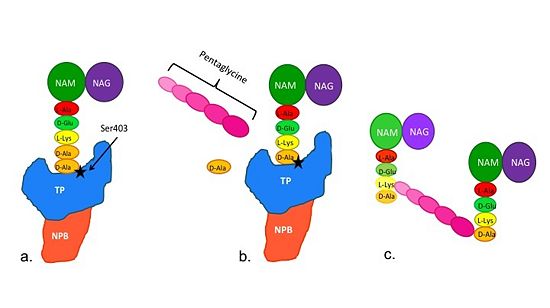Sandbox 128
From Proteopedia
(Difference between revisions)
| Line 8: | Line 8: | ||
'''Bacterial Cell Wall Structure''' | '''Bacterial Cell Wall Structure''' | ||
| - | The bacterial cell wall is crucial for maintaining the structural integrity of bacteria and protects bacteria from osmotic stress and toxic compound. The cell wall is composed of peptidoglycan (Figure 2), and in Gram positive bacterial species (e.g. S. aureus) is many layers thick, while in Gram negative bacterial species (e.g. Escherichia coli) is only a few layers thick. The difference in the number of peptidoglycan layers accounts for the differential staining of these two groups of organisms. Peptidoglycan consists of a carbohydrate portion: alternating residues of [http://en.wikipedia.org/wiki/N-Acetylmuramic_acid N-acetylmuramic Acid (NAM)] and [http://en.wikipedia.org/wiki/N-Acetylglucosamine N-acetylglucosamine (NAG)] that polymerize to form long chains, and a protein portion: a pentapeptide chain that terminates with to D-alanines (D-Ala) residues. The pentapeptide chains are covalently bound to each NAM residue. Rows of peptidoglycan are cross-linked together with pentaglycine chains to form a "mesh-like" structure. This cross-linking reaction is catalyzed by TPs. | + | The bacterial cell wall is crucial for maintaining the structural integrity of bacteria and protects bacteria from osmotic stress and toxic compound. The cell wall is composed of peptidoglycan (Figure 2), and in Gram positive bacterial species (e.g. S. aureus) is many layers thick, while in Gram negative bacterial species (e.g. Escherichia coli) is only a few layers thick. The difference in the number of peptidoglycan layers accounts for the differential staining of these two groups of organisms. Peptidoglycan consists of a carbohydrate portion: alternating residues of [http://en.wikipedia.org/wiki/N-Acetylmuramic_acid N-acetylmuramic Acid (NAM)] and [http://en.wikipedia.org/wiki/N-Acetylglucosamine N-acetylglucosamine (NAG)] that polymerize to form long chains, and a protein portion: a pentapeptide chain that terminates with to D-alanines (D-Ala) residues. The pentapeptide chains are covalently bound to each NAM residue. Rows of peptidoglycan are cross-linked together with pentaglycine chains to form a "mesh-like" structure. This cross-linking reaction is catalyzed by TPs. |
| - | + | ||
'''Catalytic Mechanism of Action of Transpeptidases''' | '''Catalytic Mechanism of Action of Transpeptidases''' | ||
[[Image:Schematic TP 3steps.jpg|thumb|alt= Alt text|Figure 2. Schematic showing Catalytic Mechanism of PBP2a |550px]] | [[Image:Schematic TP 3steps.jpg|thumb|alt= Alt text|Figure 2. Schematic showing Catalytic Mechanism of PBP2a |550px]] | ||
| Line 20: | Line 19: | ||
The B-Lactam antibiotics inhibit bacterial cell growth by irreversibly inhibiting TP's and, therefore, bacterial cell wall sythesis. Specifically, B-Lactams are molecular mimics of a portion of the peptidoglycan polymer, namely the D-Ala-D-Ala moiety, which is the normal TP enzymatic substrate(Figure 4). As a result, bacterial TP enzymes are "tricked" into reacting with B-Lactams. Additionally, the B-Lactams are very reactive molecules due to their B-lactam ring, and readily react with the TP active site serine residue and sterically block the active site preventing the entry of nucleophiles that regenerate the active site serine residue such as the pentaglycine chain or water. | The B-Lactam antibiotics inhibit bacterial cell growth by irreversibly inhibiting TP's and, therefore, bacterial cell wall sythesis. Specifically, B-Lactams are molecular mimics of a portion of the peptidoglycan polymer, namely the D-Ala-D-Ala moiety, which is the normal TP enzymatic substrate(Figure 4). As a result, bacterial TP enzymes are "tricked" into reacting with B-Lactams. Additionally, the B-Lactams are very reactive molecules due to their B-lactam ring, and readily react with the TP active site serine residue and sterically block the active site preventing the entry of nucleophiles that regenerate the active site serine residue such as the pentaglycine chain or water. | ||
| - | + | ||
'''Structure of PBP2a, a B-Lactam Resistant Transpeptidase''' | '''Structure of PBP2a, a B-Lactam Resistant Transpeptidase''' | ||
Revision as of 20:01, 30 September 2013
| |||||||||||

